2.2 – Electrical Safety: The Human Body
Effect of Electricity on the Human Body
The human body can be compared to a bag of salty water contained by different tissues such as the skin. The internal resistance of the human body is between 300 - 1000 Ω's while the intact skin is between 1 and 100 KΩ's (Reddy and Reddy, 2013). The external insulation (skin) is easily breached by wetting, scratching, lacerating or puncturing and this significantly reduces its resistance and this can significantly reduce resistance. Resistivity Decreases by 100 to 1,000 times when skin is wet or damaged.
Due to the nature of medical evaluations and treatments, patients are much more susceptible to electrical shocks. Remember, people come to hospitals because they are injured and there are many examples that can increase electrical hazards in a medical setting:
- Patients are often in a compromised situation (e.g., under anesthesia)
- Clinicians do not necessary have knowledge of electricity and maintaining a safe electrical environment
- Hypodermic needles
- Fluid-filled catheters introduced through the skin
- ECG/EEG electrodes using electrolyte gel to reduce skin resistance
- Electrical hospital beds
- Temperature probes
- Respiration sensors
- Hypothermic blanket
- Ventilators
We are now going to discuss three different physiological effects electricity has on the human body: Thermal hazards (mainly 100KHz-30MHz), Shock hazards (mainly near d.c.) and Neuromuscular effects (mainly 10-100Hz) and Heating.
Electrical Hazards and the Human Body
There are two known hazards of electricity—thermal and shock. A thermal hazard is one where excessive electric power causes undesired thermal effects, such as starting a fire in the wall of a house. A shock hazard occurs when electric current passes through a person. Shocks range in severity from painful, but otherwise harmless, to heart-stopping lethality. This section considers these hazards and the various factors affecting them in a quantitative manner.
Thermal Hazards
Electric power causes undesired heating effects whenever electric energy is converted to thermal energy at a rate faster than it can be safely dissipated. A classic example of this is the short circuit, a low-resistance path between terminals of a voltage source. An example of a short circuit is shown in Figure 2.2.1. Insulation on wires leading to an appliance has worn through, allowing the two wires to come into contact. Such an undesired contact with a high voltage is called a short. Since the resistance of the short, , is very small, the power dissipated in the short, , is very large. For example, if is 120 V and is , then the power is 144 kW, much greater than that used by a typical piece of biomedical equipment. Thermal energy delivered at this rate will very quickly raise the temperature of surrounding materials, melting or perhaps igniting them.

One particularly insidious aspect of a short circuit is that its resistance may actually be decreased due to the increase in temperature. This can happen if the short creates ionization. These charged atoms and molecules are free to move and, thus, lower the resistance . Since , the power dissipated in the short rises, possibly causing more ionization, more power, and so on. High voltages, such as the 480-V AC used in some industrial applications, lend themselves to this hazard, because higher voltages create higher initial power production in a short.
Another serious, but less dramatic, thermal hazard occurs when wires supplying power to a user are overloaded with too great a current. As discussed in the previous section, the power dissipated in the supply wires is , where is the resistance of the wires and the current flowing through them. If either or is too large, the wires overheat. For example, a worn appliance cord (with some of its braided wires broken) may have rather than the it should be. If 10.0 A of current passes through the cord, then is dissipated in the cord—much more than is safe. Similarly, if a wire with a resistance is meant to carry a few amps, but is instead carrying 100 A, it will severely overheat. The power dissipated in the wire will in that case be . Fuses and circuit breakers are used to limit excessive currents. (See Figure 2.2.2 and 2.2.3) Each device opens the circuit automatically when a sustained current exceeds safe limits.


Shock Hazards
Electrical currents through people produce tremendously varied effects. An electrical current can be used to block back pain. The possibility of using electrical current to stimulate muscle action in paralyzed limbs, perhaps allowing paraplegics to walk, is under study. TV dramatizations in which electrical shocks are used to bring a heart attack victim out of ventricular fibrillation (a massively irregular, often fatal, beating of the heart) are more than common. Yet most electrical shock fatalities occur because a current put the heart into fibrillation. A pacemaker uses electrical shocks to stimulate the heart to beat properly. Some fatal shocks do not produce burns, but warts can be safely burned off with electric current (though freezing using liquid nitrogen is now more common). Of course, there are consistent explanations for these disparate effects. The major factors upon which the effects of electrical shock depend are
- The amount of current
- The path taken by the current
- The duration of the shock
- The frequency of the current ( for DC)
Below, Table 1 gives the effects of electrical shocks as a function of current for a typical accidental shock. The effects are for a shock that passes through the trunk of the body, has a duration of 1 s, and is caused by 60-Hz power.
Table 2.2.1
Varying currents and their associated physiological effects on the human body
| Current |
Physiological and Tissue Effect |
|---|---|
| 1 mA | Sensory perception. You will begin to sense the current |
| 5 mA | Maximum accepted safe current |
| 10 mA | Maximum current before involuntary muscle contraction. “Let go” current, see Neuromuscular effects chart above |
| 50 mA | Pain occurs. Current may also cause fainting, exhaustion or mechanical injury |
| 100-300 mA | Possible cardiovascular effects such as ventricular fibrillation |
| 6 A | Sustained myocardial contraction, temporary respiratory paralysis, may experience tissue burns |
| >10 A | A person will experience all of the effects at 6A as well as incurring severe thermal burns |
Electrolysis
A DC current of 100μA through skin electrodes may cause ulceration under the electrodes. When the current passes through the body via the electrodes, the formation of sodium atoms at the negative electrode and chlorine atoms at the positive electrode causes local chemical actions which kills cells.
Neuromuscular effects
For a (15-100Hz) current passing between the hands, the following effects are expected:
Table 2.2.2
Varying currents and their corresponding neuromuscular effects
| Current | Neuromuscular reaction |
|---|---|
| 0.5-1 mA | Sensory Perception. You can begin to perceive the stimulus |
| 10 mA | 'Can't let go' current. This level of current causes contraction of the muscles to the point where you can not let go |
| 100 mA | Causes severe pain. This level of current will Interfere with your respiratory and cardiovascular functions |
| 1 A | Current will cause sustained heart contraction |
Our bodies are relatively good conductors due to the water in our bodies. Given that larger currents will flow through sections with lower resistance (to be further discussed in the next chapter), electric currents preferentially flow through paths in the human body that have a minimum resistance in a direct path to earth. The earth is a natural electron sink. Wearing insulating shoes, a requirement in many professions, prohibits a pathway for electrons by providing a large resistance in that path. Whenever working with high-power tools (drills), or in risky situations, ensure that you do not provide a pathway for current flow (especially through the heart).
Very small currents pass harmlessly and unfelt through the body. This happens to you regularly without your knowledge. The threshold of sensation is only 1 mA and, although unpleasant, shocks are apparently harmless for currents less than 5 mA. A great number of safety rules take the 5-mA value for the maximum allowed shock. At 10 to 20 mA and above, the current can stimulate sustained muscular contractions much as regular nerve impulses do. People sometimes say they were knocked across the room by a shock, but what really happened was that certain muscles contracted, propelling them in a manner not of their own choosing. (See Figure 2.2.4a) More frightening, and potentially more dangerous, is the “can’t let go” effect illustrated in 2.2.4b. The muscles that close the fingers are stronger than those that open them, so the hand closes involuntarily on the wire shocking it. This can prolong the shock indefinitely. It can also be a danger to a person trying to rescue the victim, because the rescuer’s hand may close about the victim’s wrist. Usually the best way to help the victim is to give the fist a hard knock/blow/jar with an insulator or to throw an insulator at the fist. Modern electric fences, used in animal enclosures, are now pulsed on and off to allow people who touch them to get free, rendering them less lethal than in the past.

Greater currents may affect the heart. Its electrical patterns can be disrupted, so that it beats irregularly and ineffectively in a condition called “ventricular fibrillation.” This condition often lingers after the shock and is fatal due to a lack of blood circulation. The threshold for ventricular fibrillation is between 100 and 300 mA. At about 300 mA and above, the shock can cause burns, depending on the concentration of current—the more concentrated, the greater the likelihood of burns.
Very large currents cause the heart and diaphragm to contract for the duration of the shock. Both the heart and breathing stop. Interestingly, both often return to normal following the shock. The electrical patterns on the heart are completely erased in a manner that the heart can start afresh with normal beating, as opposed to the permanent disruption caused by smaller currents that can put the heart into ventricular fibrillation. The latter is something like scribbling on a blackboard, whereas the former completely erases it. TV dramatizations of electric shock used to bring a heart attack victim out of ventricular fibrillation also show large paddles. These are used to spread out current passed through the victim to reduce the likelihood of burns.
Current is the major factor determining shock severity (given that other conditions such as path, duration, and frequency are fixed, such as in the table and preceding discussion). A larger voltage is more hazardous, but since , the severity of the shock depends on the combination of voltage and resistance. For example, a person with dry skin has a resistance of about . If he comes into contact with 120-V AC, a current passes harmlessly through him. The same person soaking wet may have a resistance of and the same 120 V will produce a current of 12 mA—above the “can’t let go” threshold and potentially dangerous.
Most of the body’s resistance is in its dry skin. When wet, salts go into ion form, lowering the resistance significantly. The interior of the body has a much lower resistance than dry skin because of all the ionic solutions and fluids it contains. If skin resistance is bypassed, such as by an intravenous infusion, a catheter, or exposed pacemaker leads, a person is rendered microshock sensitive. In this condition, currents about 1/1000 those listed in Table 3 produce similar effects. During open-heart surgery, currents as small as can be used to still the heart. Stringent electrical safety requirements in hospitals, particularly in surgery and intensive care, are related to the doubly disadvantaged microshock-sensitive patient. The break in the skin has reduced his resistance, and so the same voltage causes a greater current, and a much smaller current has a greater effect.
Macroshock: Large current passing through the skin - a small proportion may pass through the heart.
Microshock: Current applied directly to the heart (e.g. pacing leads, intracardiac temperature/pressure lines).
Characteristics of Macro- and Microshock
Table 2.2.3
Characterizing the effects of macro- and microshock.
| Macroshock | Microshock |
|---|---|
| Two contact points with an electrical circuit at different potentials | Two contact points with an electrical circuit at different potentials |
| Current level passing through the body: HIGH | Current level passing through the body: LOW |
| Skin resistance: typically not bypassed | Skin resistance: will be bypassed |
| Typically occurs because of equipment fault (Ex, breakdown of insulation, exposure of live conductors, short circuit of hot line to the case) | Typically occurs because of leakage current from stray capacitors |
Factors other than current that affect the severity of a shock are its path, duration, and AC frequency. Path has obvious consequences. For example, the heart is unaffected by an electric shock through the brain, such as may be used to treat manic depression. And it is a general truth that the longer the duration of a shock, the greater its effects. Figure 5 presents a graph that illustrates the effects of frequency on a shock. The curves show the minimum current for two different effects, as a function of frequency. The lower the current needed, the more sensitive the body is at that frequency. Ironically, the body is most sensitive to frequencies near the 50- or 60-Hz frequencies in common use. The body is slightly less sensitive for DC (), mildly confirming Edison’s claims that AC presents a greater hazard. At higher and higher frequencies, the body becomes progressively less sensitive to any effects that involve nerves. This is related to the maximum rates at which nerves can fire or be stimulated. At very high frequencies, electrical current travels only on the surface of a person. Thus a wart can be burned off with very high frequency current without causing the heart to stop. (Do not try this at home with 60-Hz AC!) Some of the spectacular demonstrations of electricity, in which high-voltage arcs are passed through the air and over people’s bodies, employ high frequencies and low currents.

AC vs DC current
Which one is more dangerous? Remember, the route cause of shock is always current, not voltage so both AC and DC can be dangerous. There are arguments for both AC and DC being more dangerous. In my opinion, AC current is more dangerous for the following reasons. The 'let-go' threshold is higher for DC than AC. As you can see in the chart below, the argument that AC current is more dangerous is based on the fact that it takes much less current to produce morbidity and mortality. The human body has a higher impedance to DC currents explaining why less AC current is needed to damage the human body.
Table 2.2.4
Effects of electricity on the human body at various direct and alternative currents and their associated level of injury
| Effect/Feeling | Direct Current - mA | Alternating Current (60Hz) - mA | Severity of Injury |
|---|---|---|---|
| Slight sensation | 1 | 0.4 | Low/None |
| Perception Threshold | 5 | 1 | Low/None |
| Shock - not painful | 9 | 2 | Low/None |
| Shock - painful | 62 | 9 | Muscle Spasm |
| Muscle contraction at source | 76 | 16 | Potentially fatal |
| Respiratory arrest | 170 | 30 | Typically fatal |
| Ventricular Fibrillation > 5 seconds exposure | 375 | 75 | Likely fatal |
| Cardiac Arrest | --- | 4000 | Likely fatal |
| Organs burn | --- | 5000 | Likely fatal |
NFPA 99 (Standards for Health Care Facilities)
The "NFPA 99 establishes criteria for levels of health care services or systems based on risk to the patients, staff, or visitors in health care facilities to minimize the hazards of fire, explosion, and electricity" (National Fire Protection Agency, 2021).
- Double-insulated appliances shall have two conductor cords: however, there are other appliances used in patient care that are provided with a three wire cord and a three pin grounding type plug
- The resistance between the appliance chassis and the ground pin of the attachment plug should be less than 0.5 ohms
- The leakage current from the ground should not exceed 5 mA in patient care areas for fixed equipment.
- The chassis leakage current for portable equipment is not to exceed 300 micro amps
- Beyond 1 KHz, the leakage limits are multiplied by the frequency (in KHz) up to a maximum of 10 mA
- The patient leads connected to the inter-cardiac catheters or electrodes should be isolated from the appliance power source
- The appliances used in general care area should be tested at least once in a year
- The appliances in critical care area should test once in every 6 months
- The primary winding of an isolated transformer in not exceed 600 V and the neutral must be grounded
Example exam question - Understanding current
Example 1
A patient is touching a medical device with one hand and grabbing the handrail of a grounded bed. If the ground wire of the medical device that shorted the chassis of the device to the live power conductor 120 V, what is the risk current passing through the patient? Assuming that each skin contact has a resistance of 25 K, and the internal body resistance is 500 Ω.
Answer:
Total resistance = [asciimath]25 kΩ + 25 kΩ + 0.5 kΩ = 50.5 kΩ[/asciimath]
The current passing trough the patient is: [asciimath](120 V)/(50.5 kΩ) = 2.4 mA[/asciimath]
Analysis:
- The patient should feel the presence of the current
- The current is not large enough to blow the fuse or trip the current breaker
- The current is not high enough to endanger the patient
Example 2
If the patient in example (1) has a heart catheter (a conductor connected directly to the heart and it is connected to ground, calculate the risk current?
Answer:
Since the catheter bypassed one skin-to-ground contact, the resistance of the current path is now reduced to [asciimath]25 kΩ + 0.5 kΩ=25.5 kΩ[/asciimath]
Therefore the risk current is equal to [asciimath](120 V)/(25.5 kΩ) = 4.7 mA[/asciimath]
Analysis:
current value (level) is still considered safe for external contact since it is directly flowing through the heart will trigger ventricular fibrillation
Attributions
The contents of this chapter is adapted from “20.6. Electric Hazards and the Human Body” College Physics, 1st edition by Paul Peter Uron, Roger Hinrichs, Openstax and is under a Creative Commons Attribution 4.0 International License. Access for free at https://openstax.org/books/college-physics/
References
- Reddy, G. N., & Reddy, G. U. (2013). Effects of Wireless Electricity on Human Bodies. International Journal of Engineering Trends and Technology,(IJETT), 4(6), 2567-2569.
- National fire protection association (2021). Health care facility codes (NFPA 99).

